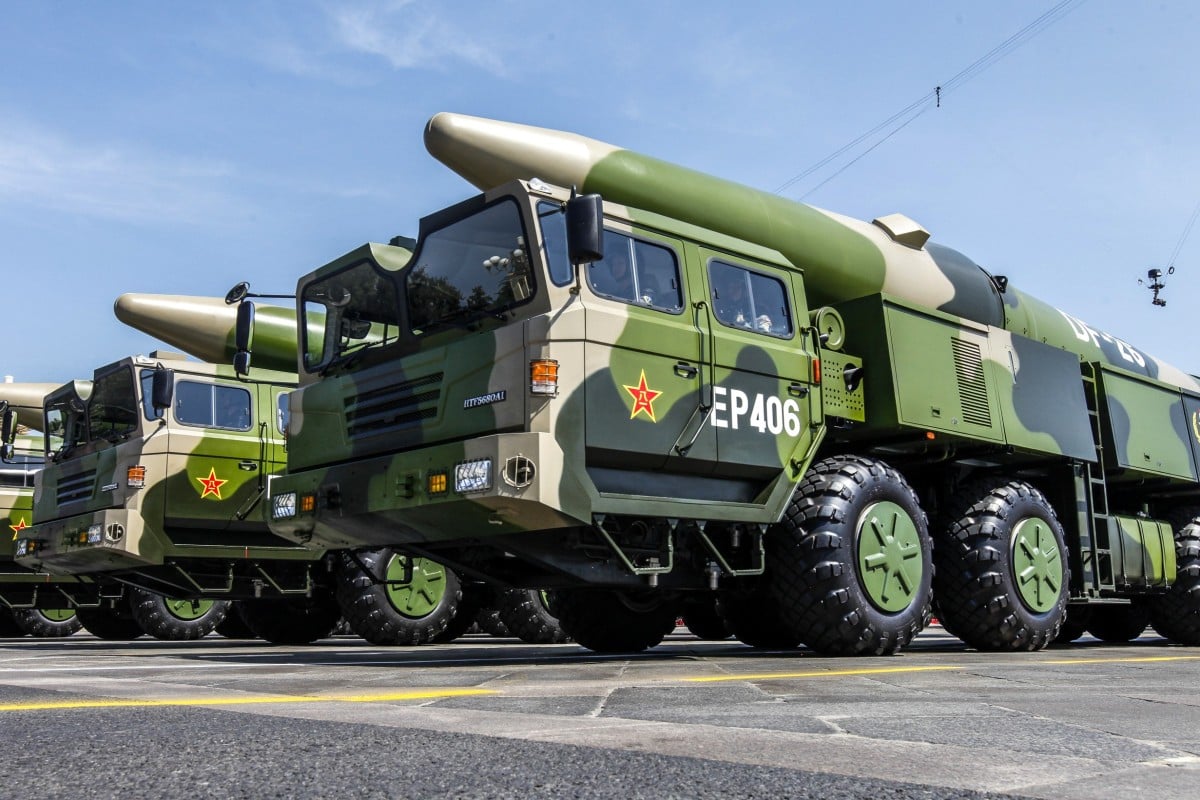US Missile Technology And The Escalation Of Tensions With China

Table of Contents
The Evolution of US Missile Technology and its Capabilities
The United States boasts a highly advanced and diverse missile arsenal, encompassing a range of systems designed for various strategic and tactical purposes. This technological superiority is a key factor influencing the balance of power in the Indo-Pacific region and beyond.
Ballistic Missiles
The backbone of US strategic deterrence is its arsenal of ballistic missiles. These long-range weapons are capable of delivering substantial payloads across vast distances with varying degrees of accuracy.
- Minuteman III: A land-based intercontinental ballistic missile (ICBM) forming the cornerstone of the US nuclear deterrent. Recent modernization efforts have enhanced its accuracy and reliability.
- Trident II D5: A submarine-launched ballistic missile (SLBM) deployed on US Navy Ohio-class submarines, providing a survivable second-strike capability. Its extended range and high accuracy make it a critical element of US strategic forces.
- Intermediate-Range Ballistic Missiles (IRBMs): While the US withdrew from the Intermediate-Range Nuclear Forces (INF) Treaty, the development and deployment of IRBMs remain a subject of ongoing debate and strategic planning.
Continuous upgrades and modernization efforts ensure the US maintains a technological edge in ballistic missile technology. These advancements involve improving accuracy, increasing payload capacity, and enhancing survivability against sophisticated anti-ballistic missile (ABM) systems.
Cruise Missiles
US cruise missiles, particularly the Tomahawk, represent a crucial element of precision strike capabilities. These weapons utilize sophisticated guidance systems, enabling them to engage targets with high accuracy, even in challenging environments.
- Tomahawk Cruise Missile: A long-range, sea-launched cruise missile capable of striking both land and sea-based targets with pinpoint precision. Its versatility makes it suitable for a wide range of military operations.
- Joint Air-to-Surface Standoff Missile (JASSM): An air-launched cruise missile designed for precision strikes against high-value targets, incorporating stealth technology to evade enemy defenses.
The employment of cruise missiles in various military scenarios, from counterterrorism operations to regional conflicts, highlights their significance in US military strategy.
Missile Defense Systems
The US has invested heavily in missile defense systems aimed at countering ballistic missile threats, particularly those posed by potential adversaries like China. However, the effectiveness of these systems remains a subject of ongoing debate.
- Aegis Ballistic Missile Defense System: A naval-based system using guided missiles to intercept ballistic missiles in their terminal phase of flight.
- Terminal High Altitude Area Defense (THAAD): A land-based system designed to intercept ballistic missiles in their terminal phase of flight.
While missile defense systems offer a degree of protection, their effectiveness is limited by factors such as the speed and maneuverability of modern ballistic missiles, as well as the potential for overwhelming attacks.
China's Response and the Arms Race Dynamics
China's rapid advancements in missile technology represent a significant challenge to US strategic interests. Beijing's growing capabilities have fueled an increasingly intense arms race, significantly impacting regional stability.
China's Missile Development
China has invested heavily in developing its own ballistic and cruise missile capabilities, including increasingly sophisticated systems designed to counter US missile defense systems.
- DF (Dongfeng) series missiles: China's DF series encompasses a range of ballistic and cruise missiles, including those with intercontinental, intermediate, and shorter ranges. These systems pose a growing threat to US forces and allies in the region.
- Hypersonic Weapons: China's reported advancements in hypersonic weapons technology represent a significant potential challenge to existing US missile defense systems.
These developments underscore the escalating military competition between the US and China and the potential for a destabilizing arms race.
Regional Instability and the South China Sea
The deployment and development of advanced missile systems by both the US and China contribute to heightened tensions and instability in the South China Sea. The presence of these weapons increases the risk of miscalculation and accidental conflict.
- Increased military activity in the region.
- Escalation of territorial disputes.
- Potential for naval confrontations.
This increased militarization has implications for regional alliances and the overall balance of power in the Indo-Pacific.
The Taiwan Strait and Potential for Conflict
The situation surrounding Taiwan represents a particularly sensitive flashpoint. The potential for conflict is amplified by the role missile technology plays in the strategic calculations of both sides.
- US missile defense capabilities to protect Taiwan.
- China’s potential military response to any perceived threat to Taiwan.
- Increased military exercises and heightened rhetoric.
The deployment of advanced missile systems on both sides of the Taiwan Strait greatly increases the risk of accidental escalation.
International Implications and the Risk of Escalation
The US-China missile arms race has far-reaching global implications, impacting international security and stability.
Global Power Dynamics
The intensifying competition between the US and China over missile technology is reshaping global power dynamics, potentially triggering a wider arms race and exacerbating existing geopolitical tensions.
- Regional instability across the globe.
- Potential proliferation of missile technology.
- Increased military spending.
This arms race threatens to destabilize international relations and undermine efforts towards global disarmament.
Diplomacy and De-escalation Strategies
The need for effective diplomacy and de-escalation strategies is paramount in mitigating the risk of conflict stemming from the US-China missile rivalry.
- Enhanced communication and transparency between the US and China.
- Reinforcement of existing arms control agreements.
- Focus on multilateral diplomatic efforts through international organizations.
Open communication and a commitment to arms control are crucial to de-escalate tensions and prevent accidental conflict.
Conclusion
The analysis of US missile technology's role in escalating tensions with China reveals a complex interplay of technological advancements, regional power dynamics, and the ever-present risk of unintended escalation. Understanding the capabilities of US missile systems, China's countermeasures, and the broader geopolitical context is crucial to addressing this challenge effectively. Further research into US missile technology and its implications for international security is necessary to develop informed strategies for conflict prevention and de-escalation. Analyzing the impact of US missile technology, and particularly understanding US missile technology in its entirety, is essential for navigating this increasingly volatile geopolitical landscape. The future of US missile technology and its role in global security will undoubtedly shape the course of international relations for years to come.

Featured Posts
-
 Stav Dedushkoy Novye Podrobnosti O Semeynoy Zhizni Mikhaelya Shumakhera
May 20, 2025
Stav Dedushkoy Novye Podrobnosti O Semeynoy Zhizni Mikhaelya Shumakhera
May 20, 2025 -
 Formula 1 Comeback Haekkinens Advice For Mick Schumacher
May 20, 2025
Formula 1 Comeback Haekkinens Advice For Mick Schumacher
May 20, 2025 -
 Analyzing Michael Schumachers Failed Comeback The Red Bull Factor
May 20, 2025
Analyzing Michael Schumachers Failed Comeback The Red Bull Factor
May 20, 2025 -
 Isabelle Nogueira E O Festival Da Cunha Uma Experiencia Cultural Na Amazonia De Manaus
May 20, 2025
Isabelle Nogueira E O Festival Da Cunha Uma Experiencia Cultural Na Amazonia De Manaus
May 20, 2025 -
 Cours D Ecriture Inspires Par Agatha Christie L Ia Au Service De La Creativite
May 20, 2025
Cours D Ecriture Inspires Par Agatha Christie L Ia Au Service De La Creativite
May 20, 2025
Latest Posts
-
 Meta Monopoly Trial Update Ftcs Defense Strategy
May 20, 2025
Meta Monopoly Trial Update Ftcs Defense Strategy
May 20, 2025 -
 The Ftcs Changing Tactics In The Meta Antitrust Case
May 20, 2025
The Ftcs Changing Tactics In The Meta Antitrust Case
May 20, 2025 -
 Meta Monopoly Trial Ftcs Defense And The Road Ahead
May 20, 2025
Meta Monopoly Trial Ftcs Defense And The Road Ahead
May 20, 2025 -
 Ftcs Defense Strategy Takes Center Stage In Meta Case
May 20, 2025
Ftcs Defense Strategy Takes Center Stage In Meta Case
May 20, 2025 -
 Canadian Tires Potential Hudsons Bay Acquisition Challenges And Opportunities
May 20, 2025
Canadian Tires Potential Hudsons Bay Acquisition Challenges And Opportunities
May 20, 2025
